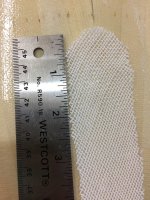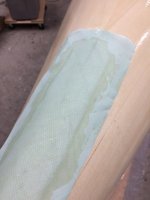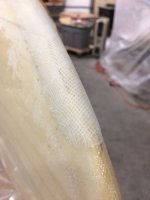G
Guest
Guest
As far as I can tell there is no such thing as selvage edged Dynel tape. This thread on the Kayak Forums was instructive. And comical at times.
http://www.kayakforum.com/cgi-bin/Building/index.cgi/md/read/id/242109/sbj/shop-dynel-tape/
“Get out in knee deep water, pick up the boat and carry it ashore”. Sure, try that in a gear-loaded boat with the waves crashing against the landing. Let me know how it works out.
My scissor cutting action remains at kindergarten level, even with fray-resistant Dynel, and I’d like to try making Dynel strips with a cleaner edge.
Rudimentary Experiment A – If I want a 2” wide Dynel strip cut the fabric to a 4” width and fold an inch underneath on each side to form a doubled over, clean-edged 2” strip of Dynel.
The ? part; somehow adhere the linear foldovers in place before laying the fabric atop an epoxy basecoat, epoxy topcoating for full fabric saturation and then laying on/rolling down the release treated peel ply.
I think repeatedly using the hard roller over peel ply as the epoxy sets up would knock down the folded outer edge agreeably. It works on the selvage edge of sewn tapes and thick swelling materials.
The Experimental Plan A question is “What glue or adhesive to use to fold over and adhere the Dynel to itself”. Something that won’t interfere with epoxy resin, and will remain somewhat pliable in stem curve application.
Some thin coat of spray adhesive would be easiest to apply. What say the builder folk?
http://www.kayakforum.com/cgi-bin/Building/index.cgi/md/read/id/242109/sbj/shop-dynel-tape/
“Get out in knee deep water, pick up the boat and carry it ashore”. Sure, try that in a gear-loaded boat with the waves crashing against the landing. Let me know how it works out.
My scissor cutting action remains at kindergarten level, even with fray-resistant Dynel, and I’d like to try making Dynel strips with a cleaner edge.
Rudimentary Experiment A – If I want a 2” wide Dynel strip cut the fabric to a 4” width and fold an inch underneath on each side to form a doubled over, clean-edged 2” strip of Dynel.
The ? part; somehow adhere the linear foldovers in place before laying the fabric atop an epoxy basecoat, epoxy topcoating for full fabric saturation and then laying on/rolling down the release treated peel ply.
I think repeatedly using the hard roller over peel ply as the epoxy sets up would knock down the folded outer edge agreeably. It works on the selvage edge of sewn tapes and thick swelling materials.
The Experimental Plan A question is “What glue or adhesive to use to fold over and adhere the Dynel to itself”. Something that won’t interfere with epoxy resin, and will remain somewhat pliable in stem curve application.
Some thin coat of spray adhesive would be easiest to apply. What say the builder folk?






